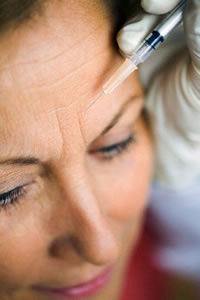 |
 |
 |
 Health & Beauty | May 2006 Health & Beauty | May 2006  
A Lift for Faces - and Moods?
 Susan Brink - LATimes Susan Brink - LATimes


| | "Wear a smile and you have friends; wear a scowl and you have wrinkles." George Eliot |
Inspired by age-old literary wisdom, countless song lyrics and the 1872 musings of Charles Darwin, a very 2006 theory to treat depression has emerged. Why not turn that frown upside down with a shot of Botox? By preventing the physical act of frowning, the muscle-paralyzing toxin just might ease depression.

A small-scale pilot trial, published in the May 15 journal Dermatologic Surgery, found that Botox injected into frown lines around the mouth or in forehead furrows of 10 women eliminated depression symptoms in nine of them and reduced symptoms in the 10th.

It's nowhere near proof that Botox can treat depression, but experts, including the study's authors, say it should be studied further in larger trials that can control for a placebo effect. After all, clinical depression will, according to the American Psychiatric Assn., affect 10% to 25% of women and 5% to 10% of men at some time in their lives.

The study results fit with a large body of psychological research that has long shown that the mere act of smiling even the most insincere "I don't want to pose for this photograph" smile makes people feel better. Frowns make them feel worse.

Volunteers asked to smile, for example, whether they wanted to or not, while watching a cartoon found it funnier than those not asked to smile, according to a 1989 study in the Annual Review of Psychology. Frown muscle activity, on the other hand, has been found to be a predictor of depression treatment outcome, according to a 1981 study in the British Journal of Psychiatry.

The finding fits too with certain treatment theories. Alcoholics Anonymous has a slogan, "Fake it till you make it," implying that acting as if you feel good actually helps you feel better. And cognitive therapy for depression often involves teaching people to cut the hangdog look.

Botox's potential to treat depression dawned on Dr. Eric Finzi, a cosmetic surgeon in Chevy Chase, Md., and lead author of the study, a few years ago, while he was studying facial expressions. Also a painter, he was working on a series of portraits based on late 19th century photographs of patients confined in the French hospital La Salpκtriθre, an institution for women "of abnormal constitution." "I went back and read Charles Darwin. Back in the 1870s, he brought up that you sort of are the emotions you express on your face," Finzi says.

Maybe, he thought, the facial muscles feed information to the emotion centers of the brain, which in turn respond with chemicals that produce happy or sad feelings. The loop is complete when those feelings are sent back to the brain, reinforcing expressions on the face. It's one theory that some researchers have held, though as yet there is no proof of such a neurological underpinning. Scientists have proven, however, that facial expressions can alter heart rate, skin temperature and blood volume.

Another theory linking facial expression and mood involves a different sort of loop a social feedback loop, illustrated and immortalized in the saying "Laugh and the world laughs with you. Weep and you weep alone." In psychological circles, it's called the facial feedback hypothesis.

So at least try to pretend that all is well. "Stop doing things that make other people feel uncomfortable," says Denise Sloan, a psychologist at Temple University in Philadelphia, who has studied people's responses to happy or unhappy expressions in depressed patients. A gloomy look sends others fleeing, leaving the depressed person isolated.

For a depressed person, who often craves isolation, pasting on a smile is far easier said than done. Kathleen Delano, 45, of Glenn Dale, Md., lived through 20 years of recurring depression. She often turned down invitations, even spent listless days in bed. She was willing to try Botox, because talk therapy and antidepressants had failed to help.

She was one of the 10 volunteers in the study. Before the injections, done once into frown muscles at five spots on the face, she scored high on a scale of depression symptoms. She and the other volunteers were also interviewed by psychologist Erika Wasserman, coauthor of the study.

Two months after the injections, her score and interview showed no symptoms of depression. "It wasn't like I had Botox one night, woke up the next day and said, 'Hallelujah, I'm cured,' " she says. But over several weeks, she found herself talking to people more, getting out more, smiling more. "I think Botox was the catalyst, the rope someone threw down the dark well I was in. I started doing things like going to the gym, to the movies."

The flaws in the study are numerous. It's so small, says Marilynn Hammond, a Mobile, Ala., psychiatrist and author of a commentary in the journal, that it should be considered anecdotal. Future studies should follow more people longer, have a control group of similar people who get placebo treatment, and use a more thorough psychiatric evaluation. "This should not suggest that this is in any way a proven treatment for depression," she says.

And there are plenty of existing treatments such as antidepressants and talk therapy that can help many people with depression, Sloan says. At a national average cost of about $400 per treatment, Botox is expensive as well as unproven.

"The thing about this that's concerning is that everyone is looking for a quick fix," she says. "When someone is severely depressed, I don't know that Botox injections would be enough. But it's intriguing." | 
 | |
 |



